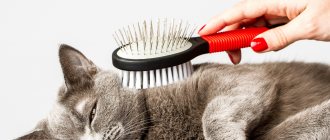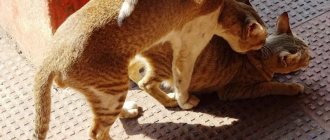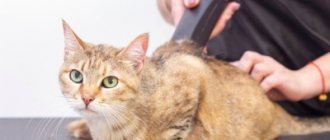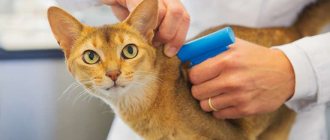International cat passport
Here is a sample of filling out an international veterinary passport for a cat - filling out this document correctly is not so difficult if you take your time and know some of the nuances. It is produced for both dogs and cats and is universal in content for most countries, including the EU.
Please note that the international veterinary passport, EU form - 576/2013 has some specifics that comply with EU standards. All column names in it are duplicated in English, and it should be filled out both in Russian and in Latin (on the Internet there are many free transliteration services translit-online.ru, service-online.su, rustolat.ru, etc.) . Currently, most clinics issue such a document the moment you come to the clinic for the first time for vaccinations or to have your pet examined. But still, you should be more careful, because in some places there could be old forms left; state in advance that you need an international veterinary passport for cats.
Don’t be surprised if the clinic gives you a document slightly different in format from the samples presented - the columns can be positioned horizontally, vertically - the main thing is to fill them out correctly. By the way, you must fill out the international veterinary passport for cats by hand, using a pen with blue or black ink.
If your veterinary passport is lost
If the cat is served in a licensed clinic, then restoring the veterinary passport will not be difficult.
And if the animal is microchipped, there will be no problems at all. It happens that a pet is served in different veterinary clinics or even at home. It is not possible to collect information in these cases. It will be necessary to obtain a new veterinary passport. You will need to undergo minor diagnostic measures and get new vaccinations (this will not harm the animal’s health).
Each owner is required to obtain a pet identification document. This procedure is not complicated; it will take a few minutes to complete, but the benefits are obvious. The animal can be transported throughout the country and abroad. In addition, all information about your pet’s health will always be at hand.
What should be specified
The cat's passport must contain the following information:
- Last name, first name and patronymic of the owner;
- Address (street, city, country).
Your full name should be written down as in your own passport. An actual address is preferable (this will make it easier to find you if necessary), and if possible, it is better to indicate both your place of residence and your place of registration.
Phone - first of all, mobile, but again it is better to write down all the numbers that you can call.
As for the photo of the pet, it should be in color, no larger than 5.5 by 8 centimeters in size and show the whole cat, not just the face.
Active components of flea drops
The composition of flea drops for cats and dogs differs slightly depending on the manufacturer. Typically the active components are:
- Invermectin is a toxic substance that can destroy various parasites. The presence of this highly toxic component in the drug requires strict adherence to the dosage.
- Permethrin is also a toxic substance. Does not pose a danger to warm-blooded animals.
- Pyriproxyfen - most often used as a impregnation for flea collars. Some manufacturers use the substance as a base for flea drops;
- Fipronil - prevents re-infestation by fleas.
Most of these substances not only poison blood-sucking insects, but also have a specific odor that repels parasites from pets.
Describing the pet
What is included in the description of a cat? The international veterinary passport for cats must contain the following information:
- The cat's nickname (the pet's name must correspond to what is indicated in the metric or pedigree - for purebred animals, if the cat is not purebred - you can write the nickname at your discretion);
- Ident. number (stamp for dogs);
- Pedigree number;
- Date of birth (also indicated by metric or pedigree. If you do not know exactly when your pet was born, write the approximate date and month);
- Gender (in this column you need to put a tick in the box F (female - female) or M (male - male). Sometimes special icons are used to indicate gender. If your passport contains the “Neuter” box, put a tick there if your the animal is sterilized);
- Breed (we copy the name of the breed from the pedigree or metric. For “nobles” we write “mixed breed”);
- Coat color (we again copy the color from the official documents of purebred cats - this can be a name or a coding. For pets of common blood, you can simply write “red”, “black with white spots”, “gray tabby”);
- Type of coat and markings / Special features.
When filling out this column, we choose from four options: hairless, shorthaired, semi-longhaired or longhaired. Special features may include “extra” fingers, torn ears, missing eyes, spots or stripes that are not typical for the breed.
Rules for antiparasitic treatment
The method of using the drops is described in detail in the instructions supplied with them. To achieve the expected result and minimize the likelihood of side effects, be sure to familiarize yourself with it before starting to treat your pet.
Where to drip?
Flea drops should be applied at the base of the animal's neck, between the shoulder blades. If the animal is large, a few drops can be distributed further along the spine, but only in those places where the animal cannot reach and lick the drug. During the procedure, you need to make sure that the liquid gets on the skin. In order for the product to be absorbed into the epidermis faster, the drops can be rubbed in yourself, but this must be done with gloves.
How many drops should you apply?
The amount of the drug is calculated based on the attached instructions. The dosage depends on the size and weight of the pet. Most often, the drops are packaged in special pipettes of different capacities or ampoules, each of which is intended for one-time treatment.
In what cases does it not help?
Sometimes it happens that after treatment with flea drops, they do not have the desired effect. Possible reasons why the drops did not help and the parasites did not die:
- the product was chosen incorrectly;
- the rules for using the drug were violated during processing;
- incorrect dosage;
- using a product that has expired;
- skipping preventative treatment.
Itches
If the treatment was carried out strictly according to the instructions and the drops did not help, it is recommended to consult a doctor.
Animal identification
The passport must also have a section on microchipping, where the microchip number, a sticker with a barcode, as well as the date of microchipping, with the doctor’s signature and the clinic’s stamp, are entered.
In some international passports you may see a section of marks from the genomic certification laboratory. These studies are needed to accurately identify animals in controversial cases or legal proceedings.
However, a microchip is enough to cross the border - today this method is the only recognized way of identifying an animal.
How to properly prepare a document
There is no uniform form of veterinary passport on the territory of the Russian Federation. So before you get one, think about your pet's future. If you have no intention of taking it abroad, then any passport form will do. An international passport will be required when transporting a cat to another country. The names of the sections in it are translated into English, and on some forms - into one or two more languages.
International veterinary passport form for your cat
Moreover, in EU countries there is a requirement for animal passports - information must also be written in Latin letters with a line after the Cyrillic alphabet. But you can purchase a form in which there are two lines in each column: you fill out the first in Cyrillic, the second in Latin. The passport can be universal for any animal, or it can be purely cat-specific. If it is possible to mate with a purebred partner or have a cat participate in exhibitions, You need to fill out all the required fields of the document as carefully and clearly as possible, and paste in a photo of the animal. In these cases, a passport is needed to process various documents and certify the breed, health and reproductive ability. But if the pet lives in your home just “for the soul”, then the veterinary passport serves as a medical card, and you will not have to present it anywhere except a veterinary hospital.
How to fill out owner information correctly
The passport contains several columns about the owner of the animal. This is necessary in order to include the new owner of the cat when selling or donating. Sometimes the document has a separate column “breeder”, where his data is entered. If there is no such field, information about the breeder is entered in the “owner” field. Then the person, when purchasing a kitten, lists himself as the second owner.
You can fill out the column about the cat's owner yourself
How to enter information about a cat correctly
The first column “photo” is optional. But if you decide to paste a photo of your pet, then wait until he is one year old. Information about the pet must be written down as clearly as possible. The animal's name is written with a capital letter. It is copied from the breeder’s metrics or invented by themselves. If you know the cat's breed, write down its exact name. For a purebred cat, indicate “mixed breed.” With color, everything is a little more complicated. If you did not take the kitten from a breeder, or he did not indicate the coat color in the passport, you will have to check the color chart. You can write down the white and black color yourself; it is better to specify the remaining shades or spotting. Also indicate the type of coat - short-haired, semi-long-haired or long-haired. You can indicate an approximate date of birth if you do not know the exact one. The gender of the animal can be indicated “Male/Female”, then Underline what is necessary. Otherwise, write Male if you have a cat or Female if you have a cat. You cannot write the gender of an animal with the words “female”, “male”, “male”, “female” or in any other way. Some passports have a column “special o. Features of the color or body structure of the animal are recorded there. For example, the absence of an ear, a white spot on a paw, or a curvature of a vertebra in the tail.
The “cat identification” section is filled out by a veterinarian in case of microchipping or tattooing. The date of the procedure, number and location of the microchip or tattoo must be indicated.
In the section where the cat is described, fill in all required fields!
Features of filling out data on animal registration and vaccination
Information about registering a cat in a veterinary clinic is filled out by a veterinarian. If you purchased an adult animal, you need to mark it within a month. Kittens are usually registered for their first vaccination at 2–3 months of age. Information about vaccinations is also included in the cat’s passport by the veterinarian after vaccination. There must be a date, a doctor’s signature and a stamp from the institution. A label from the vaccine ampoule is also affixed to the passport. The veterinary passport has separate columns for vaccinations against rabies and viral diseases.
Best articles: TOP 10 largest dog breeds in the world - names, photos and brief descriptions
But keep in mind that if you yourself know how to give injections to a cat and decide to buy the vaccine yourself, then such a vaccination is considered invalid. The vaccination record must be certified by the seal of a veterinary clinic, otherwise it will be impossible to obtain a veterinary certificate or certificate for the animal. This is exactly the situation that happened to my sister: she urgently needed to go to another city, and she vaccinated the cat herself. And I couldn’t get a veterinary certificate to transport an animal on the train! We had to urgently look for a shelter for the pet for two weeks, since in order to obtain a certificate it was necessary to vaccinate the cat again and wait 30 days.
Vaccination entries are the most important in a veterinary passport
Registration date
The second page is reserved for notes on the registration of the animal at the veterinary clinic, which are made within 1 month from the date of purchase of adult animals, and puppies and kittens upon reaching 3 (2) months of age.
Re-registration is carried out after 1 year from the date of registration and then no later than 2 months from the date of expiration. Remember that re-registration notes must be made by a veterinarian - all of them are accompanied by the doctor’s signature and the clinic’s stamp with the license number.
Why drops?
Veterinary pharmacies offer a wide range of products designed to protect pets from fleas. They are available in the form of sprays, aerosols, shampoos and collars soaked in a special solution.
Despite this variety, veterinarians advise using drops. This form of insecticide is considered the most convenient and effective, since the drops are able to penetrate the skin of the animal and effectively protect it from parasites.
When using sprays, the composition is sprayed onto several sentiments around. At the same time, it can get into those areas that the animal will lick, which can provoke poisoning.
Licks himself
Flea collars also have disadvantages:
- if worn incorrectly, it may rub your neck;
- while wearing it, if the collar gets caught, the pet may be injured;
- not every animal will wear a protective attribute.
As for the drops, their use will not cause discomfort to the pet. In addition, the owner can easily apply the drug to the pet’s withers without fear that the animal will lick the composition.
Vaccination data
The following is a section with notes on rabies vaccination. Each mark contains a date, type of vaccine (sticker), a stamp with the vaccine batch number, a veterinarian’s signature, and a clinic seal.
The section on basic vaccination contains information on vaccinations against panleukopenia, rhinotracheitis and calcivirosis, and is completed in the same way as the previous section.
In special sections on deworming and treatment for fleas and ticks, marks are made and drug stickers are pasted. This can be done either by the owner himself or by the doctor.
Place of receipt and registration rules
The passport is issued by a veterinarian at a state clinic. A blank form can be purchased locally and immediately given to a specialist to fill out the information. It is better to check on the spot how much this service will cost.
Sample of a blank international passport
Typically, a veterinary passport is obtained when the puppy is first vaccinated. After the procedure, a record of vaccination is added to the document. Therefore, most often the breeder receives a passport.
New passports are more convenient to use. In addition to information about medical treatments, they provide additional fields for notes and repetition of section names in international English.
Note! Any entry must be certified by the signature of a veterinarian and the seal of the medical institution, otherwise the data will not be included when passing control at the border. The seal of the kennel club is not enough to confirm information











